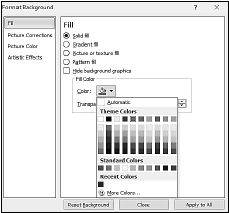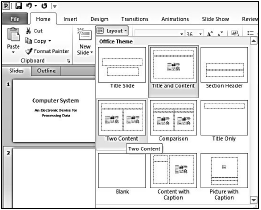Students can read the important questions given below for Microsoft PowerPoint (Part-2) Science Class 8 Computer Science. All Microsoft PowerPoint (Part-2) Science Class 8 Notes and questions with solutions have been prepared based on the latest syllabus and examination guidelines issued by CBSE, NCERT and KVS. You should read all notes provided by us and Class 8 Computer Science Important Questions provided for all chapters to get better marks in examinations. Computer Science Question Bank Class 8 is available on our website for free download in PDF.
Important Questions of Microsoft PowerPoint (Part-2) Science Class 8
Very Short Answer Type Questions:
Question: What is the Shortcut Key to Insert a New Slide?
Ans: Ctrl + M
Question: What is the shortcut key to Create a New Presentation?
Ans: Ctrl+ N
Question: Which tab is used to format text on the slide?
Ans: Home tab
Question: Which PowerPoint view is used to deliver our presentation to an audience?
Ans: Slide Show view
Question: Which bar contains the View buttons and Zoom Slider in PowerPoint?
Ans: Status Bar
Short Answer Type Questions:
Question: Write the steps to create a new presentation using File tab in PowerPoint.
Ans: Following are the steps to create a new presentation file using the File tab:
1. Click on the File tab.
2. Click on the New option.
3. Click on Blank Presentation.
4. Click on the Create button.
Question: What are Placeholders?
Ans: The placeholder are the dotted-line containers that are shown on the slide layout. They can hold a variety of content, such as: Title, Table, Chart, Pictures, ClipArt, etc.
Question: What are Themes?
Ans: A theme is a predefined set of colours, fonts and visual effects. We use themes in our presentation to set a consistent and professional look of our slides.
Question: Write the names of different view buttons available at the status bar of PowerPoint window.
Ans: The status bar has four view buttons with a zoom slider:
• Normal View
• Slide Sorter View
• Reading View
• Slide Show View

Question: What is Gradient Fill?
Ans: A gradient is a mixture of two or more colours that merge with each other. The Gradient Fill is an option which is used to apply the gradient as a slide background. This option appears in the Format Background dialog box.
Question: Which options are available in the Fill pane of the Format Background dialog box?
Ans: The Fill Pen has the following options:
• Solid Fill
• Gradient Fill
• Picture or Texture Fill
• Pattern Fill

Long Answer Type Questions:
Question: Explain briefly about the different methods to change the appearance of slides?
Ans: We can easily change the appearance of slides using the options available in the Design tab of PowerPoint. The main methods to change the appearance of a slide are as follows:
• Themes: A theme is a predefined set of colours, fonts, and visual effects. We use Themes to set a consistent and professional look of our slides.
• Background style: The pictures or design elements that are placed behind the text, charts, etc. on the slides are called PowerPoint backgrounds. We can change these backgrounds of slides with the help of the Background Styles option.

Question: What is Slide Layout? How will you change it in PowerPoint?
Ans: Slide layout defines the design and placement of different elements on a slide. We can also change the layout of the slide after inserting the slide into the presentation. The steps are as follows:
1. Select the slide whose layout we want to change.
2. Click on the Layout drop-down menu in the Slides group of the Home tab.
3. Click on the layout as per the requirement.

Question: Write about the Slide View options in PowerPoint.
Ans: Following is the description of PowerPoint’s slide view options:
• Normal View: This is the default view where we create, edit and design our slides.
• Slide Sorter View: This view displays presentation slides in thumbnail form.
• Reading View: This view fills most of the computer screen with a preview of our presentation.
• Slide Show View: We use Slide Show View to display our presentation to the audience.




